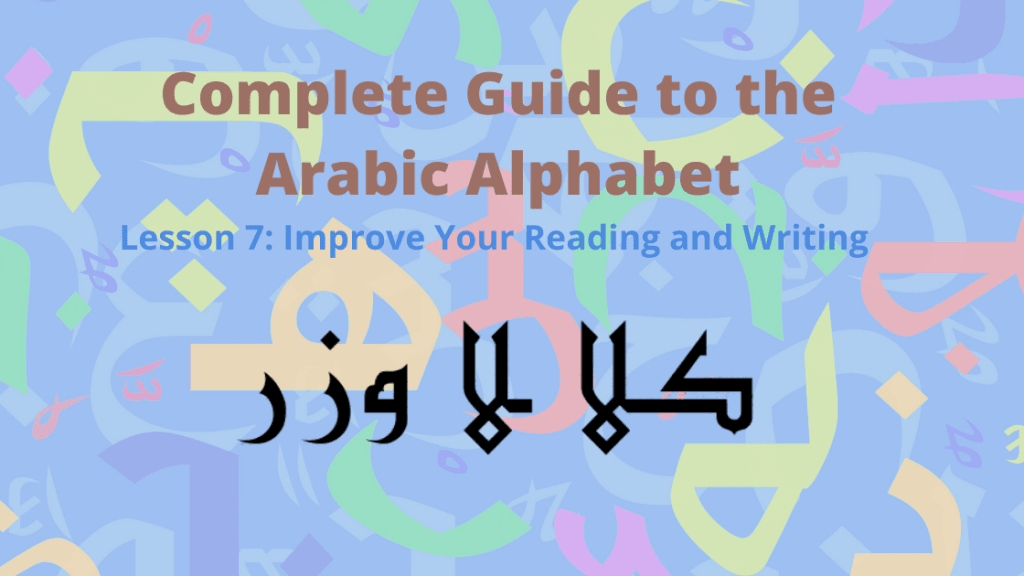Improve Your Reading
& Writing

· Now you know how to identify and write the first 7 letters
· But, depending on which other letters these 7 connect to, the script can look slightly different, as you may have noticed from some exercises
· So let’s take a look at a few examples and try to figure out what letters we’re looking at and how to figure it out
كلا
لا وزر
·
Sometimes the Aleph is
curved like you see twice in the example above
This happens when the letter ل (Laam; English “L”) comes before it
با
تا ثا جا حا خا
دا
ذا را زا
سا
شا صا ضا طا ظا
عا غا فا قا كا
لا
ما نا
وا
ها
يا
·
Here is the Aleph with each
letter of the alphabet coming before it
Notice that not all letters connect to the letter following
There will be a small gap; notice the size of the gap
·
Also notice that two
letters (ط and ظ)
already have a line as part of their body
Careful not to confuse this for an Aleph
ثمانية
ثـمانية
·
The bodies of Baa, Taa and
THaa are sometimes written like a semicircle
Notice the THaa in the first word above
The second word is exactly the same except that the THaa has been written
normally (we exaggerated the connection a bit, though)
تمام
بماء
·
The same goes for Baa and
Taa
This semicircle style is optional
It looks nice, though
And it only happens when the following letter is م
(Meem; English “M”)
ثمانية
·
Notice the last letter in
the word above
It’s a Taa! Notice the two dots on top!
Taa is one of only 2 letters with 2 dots on top
The other letter is ق (Qaaf; English “Q”) and this is NOT a Qaaf
·
This is actually kind of
complicated
This letter is both a Taa and a Haa (not the Haa we learned about in this
lesson; another Haa)
· Sometimes you pronounce it like Taa, and sometimes like Haa
·
We’ll talk more about this
when we talk about Haa
But basically, a Taa can look like this
This only happens at the end of words
You’ll never see this in the beginning or middle of a word,
guaranteed
بج
بجج
·
Notice the beginnings of
both of the above words
In the first one, everything looks normal
But in the second one, the Baa is stacked on top of the first Jeem
·
This can only happen with
the letters Jeem, Haa, and KHaa
It happens when any letter comes before them in the beginning of a word
·
Let’s say we have a Haa as
the first letter
Then we have a Jeem
You are allowed to stack the Haa on top of the Jeem
·
And if after the Jeem
there’s another Jeem, for example
then you can even stack the first Jeem on the second one
to get 3 levels of stacking
·
This often looks nice
But usually one level is more than enough
And most Arabic computer fonts won’t let you do more than one level
And they only do stacking with certain letters before the Jeem, Haa or KHaa
بجج
·
In the example above, the
dot of the stacked Baa is in the same line as the other dots in the word,
roughly
But you are allowed to move the dot of this Baa up so it’s under the body of
the Baa
محال
· Here’s another example with a م (Meem; English “M”)
·
This has been an overview
of stacking
There’s not much more to it, actually
But there are some small rules that we didn’t cover here
But nobody follows them anyways
· Stacking is taught in grade 8 in many Arab countries
This lesson was authored by Mohtanick Jamil
FREE Course
-
LEVEL 1
- 1 About the Arabic Alphabet
- 2 Letter Aleph
- 3 Letters Baa, Taa, THaa
- 4 Vowel Fatha
- 5 Lesson Review
- 6 Letters Jeem, Haa, KHaa
- 7 Reading & Writing Review
- 8 Letters Daal, Dhaal
- 9 Letters Raa, Zeiy
- 10 Pronunciation Review
- 11 Letters Seen, SHeen
- 12 Letters Saad, Daad
- 13 Vowels Kasra, Damma
- 14 Letters Taa, Zaa
- 15 Letters Ein, GHein
- 16 Arabic Syllables
- 17 Letters Faa, Qaaf, Kaaf
- 18 Letters Laam, Meem, Noon
- 19 Rest of the Alphabet
- 20 Review & Practice
- 21 Double Vowel
- 22 Reading Arabic Sentences
LEVEL 2
LEVEL 3
LEVEL 4
LEVEL 5